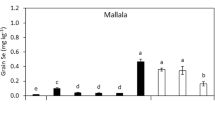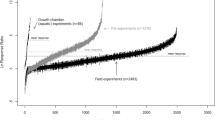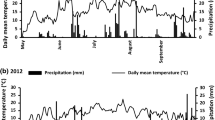Abstract
Deficiency in calcium, zinc, selenium, and iodine remains a major health issue in Africa. A selenium (Se) status survey conducted in central Kenya highlands revealed a high risk of dietary Se deficiency. This study investigates the effect of soil and foliar Se fertilizer application on Se concentration in maize and bean grains. It further tests the combination of Se fertilizer with phosphorus and nitrogen fertilizers, and with zinc and iodine fertilizers. Selenium fertilization results in a significant increase in Se concentration in grains. For the soil application, Se concentration increases on average by 3 µg kg−1 in maize and by 10 µg kg−1 in beans, for each gram of Se applied as sodium selenate. Foliar Se fertilization is more effective and increases Se concentration in grains on average by 18 µg kg−1 in maize, and by 67 µg kg−1 in beans. Total soil phosphorus/availability appears as an important factor influencing soil Se availability. Addition of phosphorus fertilizers positively affects the impact of Se fertilization in locations with low soil P, Fe, and Al. A Se + Zn + I fertilizer combination does not affect the impact on Se concentration in grains. Fertilizing beans alone is found to be more efficient compared to fertilizing only maize. In locations at high risk of dietary Se deficiency, foliar application at 10 g Se ha−1 on beans or 31 g Se ha−1 on maize is sufficient to achieve adequate daily dietary Se intake. The study points towards a multi-mineral agronomic biofortification, based on a site-specific biofortification strategy.


Similar content being viewed by others
Notes
One-way ANOVA (Post Hoc Test) for maize between Mbeu and Kiaga: p value = 0.377 (control), 0.979 (5 g Se ha−1), 0.307 (10 g Se ha−1), 0.784 (20 g Se ha−1).
References
Beck, M. A. (2001). Antioxidants and viral infections: Host immune response and viral pathogenicity. Journal of the American College of Nutrition,20, 384–388.
Blaylock, M. J., & James, B. R. (1994). Redox transformations and plant uptake of selenium resulting from root-soil interactions. Plant and Soil,158(1), 1–12.
Broadley, M. R., White, P. J., Bryson, R. J., Meacham, M. C., Bowen, H. C., Johnson, S. E., et al. (2006). Biofortification of UK food crops with selenium. Proceedings of the Nutrition Society,65(02), 169–181.
Carter, M. R., & Gregorich, E. G. (2007). Soil sampling and methods of analysis (2nd ed.). Cambridge: CRC Press.
Chen, L., Yang, F., Xu, J., Hu, Y., Hu, Q., Zhang, Y., et al. (2002). Determination of selenium concentration of rice in China and effect of fertilization of selenite and selenate on selenium content of rice. Journal of Agricultural and Food Chemistry,50, 5128–5130.
Chilimba, A. D. C., Young, S. D., Black, C. R., Meacham, M. C., Lammel, J., & Broadley, M. R. (2012). Agronomic biofortification of maize with Selenium (Se) in Malawi. Field Crops Research. https://doi.org/10.1016/j.fcr.2011.08.014.
Chilimba, A. D. C., Young, S. D., Black, C. R., Rogerson, K. B., Louise Ander, E., Watts, M. J., et al. (2011). Maize grain and soil surveys reveal suboptimal dietary selenium intake is widespread in Malawi. Scientific Reports. https://doi.org/10.1038/srep00072.
Combs, G. F. (2001). Selenium in global food systems. British Journal of Nutrition,85(05), 517.
De Temmerman, L., Waegeneers, N., Thiry, C., Du Laing, G., Tack, F., & Ruttens, A. (2014). Selenium content of Belgian cultivated soils and its uptake by field crops and vegetables. Science of the Total Environment,468–469, 77–82.
Dhillon, K. S., & Dhillon, S. K. (1999). Adsorption–desorption reactions of selenium in some soils of India. Geoderma,93, 19–31.
Dhillon, S. K., & Dhillon, K. S. (2000). Selenium adsorption in soils as influenced by different anions. Journal of Plant Nutrition and Soil Science,163(6), 577–582.
Du Laing, G. (2010). Analysis and Fractionation of element in Soils. In P. S. Hooda (Ed.), Trace elements in soils (pp. 53–80). Chichester: Wiley-Blackwell.
Ducsay, L., Lozek, O., Marcek, M., Varenyiova, M., Hozlar, P., & Losak, T. (2016). Possibility of selenium biofortification of winter wheat grain. Plant Soil and Environment,62(8), 379–383.
Duncan, E. G., Maher, W. A., Jagtap, R., Krikowa, F., Roper, M. M., & O’Sullivan, C. A. (2017). Selenium speciation in wheat grain varies in the presence of nitrogen and sulphur fertilisers. Environmental Geochemistry and Health,39, 955–966.
Eich-Greatorex, S., Krogstad, T., & Sogn, T. A. (2010). Effect of phosphorus status of the soil on selenium availability. Journal of Plant Nutrition and Soil Science,173(3), 337–344.
Fairweather-Tait, S. J., Bao, Y., Broadley, M. R., Collings, R., Ford, D., Hesketh, J. E., et al. (2011). Selenium in Human Health and Disease. Antioxidants & Redox Signaling,14(7), 1337–1383.
Fordyce, F. M. (2013). Selenium deficiency and toxicity in the environment. In Essentials of medical geology: Revised edition (pp. 375–416). Dordrecht: Springer Netherlands. https://doi.org/10.1007/978-94-007-4375-5_16.
Giachene, C., & Kimaru, G. (2003). Soil fertility and land productivity: A guide for extension workers in the eastern Africa region. Technical Handbook No. 30. http://www.worldagroforestry.org/downloads/Publications/PDFS/B13197.pdf. Accessed June 10, 2018.
Gibson, R. S., & Hotz, C. (2001). Dietary diversification/modification strategies to enhance micronutrient content and bioavailability of diets in developing countries. British Journal of Nutrition,85(S2), S159.
Graham, R. D., Welch, R. M., Saunders, D. A., Hyphen, T. G., Bouis, H. E., Bonierbale, M., et al. (2007). Nutritious subsistence food systems. Advances in Agronomy,92, 1–74.
Gupta, M., & Gupta, S. (2017). An overview of selenium uptake, metabolism, and toxicity in plants. Frontiers in Plant Science,7, 1. https://doi.org/10.3389/fpls.2016.02074.
Hurst, R., Siyame, E. W., Young, S. D., Chilimba, A. D., Joy, E. J., Black, C. R., Ander, E. L., Watts, M. J., Chilima, B., Gondwe, J., Kang’ombe, D., Stein, A. J., Fairweather-Tait, S. J., Gibson, R. S., Kalimbira, A. A., Broadley, M. R. (2013). Soil-type influences human selenium status and underlies widespread selenium deficiency risks in Malawi. Scientific Reports,3(2), 1–6.
ICH. (2005). ICH Topic Q2 (R1) validation of analytical procedures: text and methodology. In International conference on harmonization, 1994 (June 1995). https://www.ema.europa.eu/documents/scientific-guideline/ich-q-2-r1-validation-analytical-procedures-text-methodology-step-5_en.pdf. Accessed April 4, 2018.
Institute of Agricultural Policy, T. (2013). Kenya Country Survey Report on FTF Zone of Influence Population Based Survey. https://www.feedthefuture.gov/wp-content/uploads/2018/03/Kenya_ZOI_Baseline_Report_May2013.pdf. Accessed September 1, 2018.
Institute of Medicine. (2000). Dietary Reference Intakes for Vitamin C, Vitamin E, Selenium, and Carotenoids Panel on Dietary Antioxidants and Related Compounds, Subcommittees on Upper Reference Levels of Nutrients and Interpretation and Uses of DRIs, Standing Committee on the Scientific Evaluation of Dietary Reference Intakes. The National Center for Biotechnology Information, 529(9), 309.
Jayne, T. S., & Muyanga, M. (2012). Land constraints in Kenya’s densely populated rural areas: Implications for food policy and institutional reform. Food Security,4(3), 399–421.
Joy, E. J. M., Ander, E. L., Broadley, M. R., Young, S. D., Chilimba, A. D. C., Hamilton, E. M., et al. (2017). Elemental composition of Malawian rice. Environmental Geochemistry and Health,39, 835–845.
Joy, E. J. M., Ander, E. L., Young, S. D., Black, C. R., Watts, M. J., Chilimba, A. D. C., et al. (2014). Dietary mineral supplies in Africa. Physiologia Plantarum,151(3), 208–229.
Karmakar, R., Das, I., Dutta, D., & Rakshit, A. (2016). OPEN ACCESS science international review article potential effects of climate change on soil properties: a review. Science International,51, 51–73.
Kennedy, G. L., Pedro, M. R., Seghieri, C., Nantel, G., & Brouwer, I. (2007). Dietary diversity score is a useful indicator of micronutrient intake in non-breast-feeding Filipino children. The Journal of Nutrition,137(2), 472–477.
Kirchmann, H., Mattsson, L., & Eriksson, J. (2009). Trace element concentration in wheat grain: results from the Swedish long-term soil fertility experiments and national monitoring program. Environmental Geochemistry and Health,31, 561–571.
Lal, R. (2006). Enhancing crop yields in the developing countries through restoration of the soil organic carbon pool in agricultural lands. Land Degradation and Development,17(2), 197–209.
Lavu, R. V. S., De Schepper, V., Steppe, K., Majeti, P. N. V., Tack, F., & Du Laing, G. (2013). Use of selenium fertilizers for production of Se-enriched Kenaf (Hibiscus cannabinus): Effect on Se concentration and plant productivity. Journal of Plant Nutrition and Soil Science,176(4), 634–639.
Lawson, P. G., Daum, D., Czauderna, R., Meuser, H., & Härtling, J. W. (2015). Soil versus foliar iodine fertilization as a biofortification strategy for field-grown vegetables. Frontiers in Plant Science. https://doi.org/10.3389/fpls.2015.00450.
Liu, Q., Wang, D. J., Jiang, X. J., & Cao, Z. H. (2004). Effects of the interactions between selenium and phosphorus on the growth and selenium accummulation in rice (Oryza sativa). Environmental Geochemistry and Health,29, 325–330.
Lyons, G. H., Lewis, J., Lorimer, M. F., Holloway, R. E., Brace, D. M., Stangoulis, J. C. R., et al. (2004a). High-selenium wheat: agronomic biofortification strategies to improve human nutrition. Food, Agriculture and Environment,2(1), 171–178.
Lyons, G. H., Stangoulis, J. C., & Graham, R. D. (2004b). Exploiting micronutrient interaction to optimize biofortification programs: The case for inclusion of selenium and iodine in the HarvestPlus program. Nutrition Reviews. https://doi.org/10.1301/nr2004.jun247-252.
Mao, H., Wang, J., Wang, Z., Zan, Y., Lyons, G., & Zou, C. (2014). Using agronomic biofortification to boost zinc, selenium, and iodine concentrations of food crops grown on the loess plateau in China. Journal of Soil Science and Plant Nutrition,14, 459–470.
Micronutrient Initiative. (2009). Investing in the Future: A united call to action on vitamin and mineral deficiencies—Global report 2009. https://reliefweb.int/sites/reliefweb.int/files/resources/E7048CF2A553C171492576DB001FB2E2-Investing_in_the_future.pdf. Accessed May 2, 2018.
Mistry, H. D., Broughton Pipkin, F., Redman, C. W., & Poston, L. (2012). Selenium in reproductive health. American Journal of Obstetrics and Gynecology,206(1), 21–30.
MoA. (2013). Economic Review of Agriculture [ERA]. https://books.google.co.uk/books?id=wplfnQAACAAJ. Accessed September 6, 2018.
MoH. (2017). National iron & folic acid supplementation. https://www.k4health.org/sites/default/files/ifas_national_comunication_strategy_2013-2017.pdf. Accessed January 2, 2018.
MoH, KeMRI, & KNBS. (2013). The Kenya National Micronutrient Survey 2011. http://www.nutritionhealth.or.ke/wp-content/uploads/Downloads/TheKenyaNationalMicronutrientSurvey2011.pdf. Accessed May 3, 2018.
Mombo, S., Schreck, E., Dumat, C., Laplanche, C., Pierart, A., Longchamp, M., et al. (2016). Bioaccessibility of selenium after human ingestion in relation to its chemical species and compartmentalization in maize. Environmental Geochemistry and Health,38, 869–883.
Peterson, P. J., & Butler, G. W. (1962). The Uptake and Assimilation of selenite by higher plants. Australian Journal of Biological Sciences,24(2), 175–178.
Rayman, M. P. (2008). Food-chain selenium and human health: Emphasis on intake. British Journal of Nutrition,100(2), 254–268.
Reis, H. P. G., Barcelos, J. P., Junior, E. F., Santos, E. F., Silva, V. M., Moraes, M. F., et al. (2018). Agronomic biofortification of upland rice with selenium and nitrogen and its relation to grain quality. Journal of Cereal Science,79, 508–515.
Ros, G., Los, D., Bussink, W., & Bindraban, P. S. (2016). Selenium fertilization strategies for bio-fortification of food: An agro-ecosystem approach. Plant and Soil. https://doi.org/10.1007/s11104-016-2830-4.
Tapiero, H., Townsend, D. M., & Tew, K. D. (2003). The antioxidant role of selenium and seleno-compounds. Biomedicine & Pharmacotherapy,57(3), 134–144. https://doi.org/10.1016/S0753-3322(03)00035-0.
Ullah, H., Liu, G., Yousaf, B., Ali, M. U., Irshad, S., Abbas, Q., et al. (2018). A comprehensive review on environmental transformation of selenium: recent advances and research perspectives. Environmental Geochemistry and Health. https://doi.org/10.1007/s10653-018-0195-8.
Vineyard, B. (2010). Plant nutrition. Forum American Bar Association, 49(April), 27,1,183.
Wang, J., Wang, Z., Mao, H., Zhao, H., & Huang, D. (2013). Increasing Se concentration in maize grain with soil- or foliar-applied selenite on the Loess Plateau in China. Field Crops Research,150, 83–90.
Wang, Q., Yu, Y., Li, J., Wan, Y., Huang, Q., Guo, Y., et al. (2017). Effects of different forms of selenium fertilizers on Se accumulation, distribution, and sesidual effect in winter wheat-summer maize rotation yystem. Journal of Agriculture and Food Chemistry,65, 1116–1123.
White, P. J., & Broadley, M. R. (2009). Biofortification of crops with seven mineral elements often lacking in human diets—Iron, zinc, copper, calcium, magnesium, selenium and iodine. New Phytologist. https://doi.org/10.1111/j.1469-8137.2008.02738.x.
Zhao, C., Ren, J., Xue, C., & Lin, E. (2005). Study on the relationship between soil selenium and plant selenium uptake. Plant and Soil,277(1–2), 197–206.
Zhao, F., & McGrath, S. P. (1994). Extractable sulphate and organic sulphur in soils and their availability to plants. Plant and Soil,164(2), 243–250.
Acknowledgements
We thank VRIL-OUS: Vlaamse Interuniversitaire Raad voor Universitaire Ontwikkelingssamenwerking (Flemish Interuniversity Council for University development cooperation) for funding this project as part of ICP-PHD scholarships, as well as Meru University of Science and Technology in Kenya for granting a study leave in support of the project. We are also very grateful to the location chiefs and village managers who helped organize the field experiments, and to the households who offered their time and part of their farms for conducting the experimental trials.
Author information
Authors and Affiliations
Corresponding author
Additional information
Publisher's Note
Springer Nature remains neutral with regard to jurisdictional claims in published maps and institutional affiliations.
Rights and permissions
About this article
Cite this article
Ngigi, P.B., Lachat, C., Masinde, P.W. et al. Agronomic biofortification of maize and beans in Kenya through selenium fertilization. Environ Geochem Health 41, 2577–2591 (2019). https://doi.org/10.1007/s10653-019-00309-3
Received:
Accepted:
Published:
Issue Date:
DOI: https://doi.org/10.1007/s10653-019-00309-3




